February 18
(Click on all images to enlarge them).

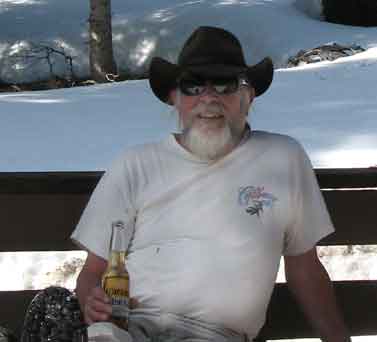
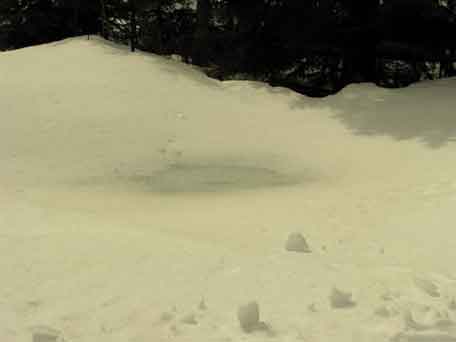
We didn't let that bother us though! But the pond wasn't much to see - but it did look like it was already starting to thaw!!
April
(Click on all images to enlarge them).
Our next visit to our McCloud home and pond wasn't until mid-May as we took a trip to the east coast in April. BUT - our neighbor took this
image when they went up on April 6th to assure us that all was well. Thanks Rick and Penny!!
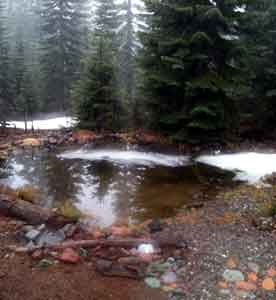
It was good to know that the pond was thawing.
May
(Click on all images to enlarge them).
FINALLY on May 20, we were able to return to our McCloud retreat!...and it looked just as we hoped it would! In fact, several plants were
blooming for their very first time! Purple Larkspur was blooming just behind the pond, the Bog Bean was abloom IN the pond, and the
Bleeding Heart, just outside the pond, too! A special treat was finding Marsh Marigold not only growing, but also in bloom
and attracting pollinators too!
All these plants are native to Siskiyou County, California, where our McCloud home is located.
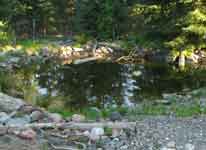
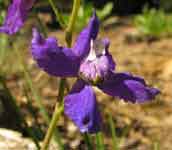


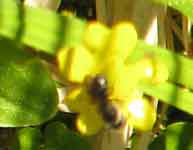
One plant had gone so far as to be too successful though, and I spent some time pulling up this grass from the beach. The water was
down about 6" because we hadn't been there since the winter thaw and hadn't set up the timer on our water tank to release water into
the pond. We run a hose/underground pipe from the 2500 gallon water tank that we pump water into to the bog area of the pond. The
plants in the bog reduce the nutrient load of the water, preventing the green algae from growing as it had when we only used a hose into the
pond...I had almost forgotten this and in the picture we're refilling the pond just letting the water run into the pond. This isn't
a good idea, and I soon remembered that!
Another thing that, although natural, we weren't too thrilled with was the number of paper wasps that were on the pond!
We have at least 2 kinds; the first one below is a Golden Paper Wasp. They often land on the surface of the water,
and luckily don't seem too agressive. Very close in appearance, but not exactly the same, and a non-native species (drat!) is the European Paper Wasp.
We also have the Western Yellowjacket which IS aggressive, esp. near their underground nest, but I didn't manage to photograph it.

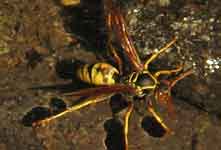
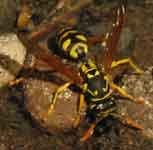
We had quite a few species of "Leps" at the pond - both butterflies and moths. Mostly they use the pond as a mineral lick. They perch
on the beach and put their proboscis down into the wet sand, gathering minerals. I believe that it is the males which do this, and that
they need these minerals for mating. I looked it up and learned that this is mostly seen in male butterflies. That's because males incorporate those extra salts and minerals into their sperm.
When butterflies mate, the nutrients are transferred to the female through the sperm. These extra salts and minerals improve the viability of the female's eggs,
increasing the couple's chances of passing on their genes to another generation. So having a beach on a wildlife pond is especially
good for butterflies! Yay!! The first species I was able to photograph this month was the Six-spotted Litocala Moth - it is
a day flying month that lays its eggs on the chinquapin that grows abundantly on our property, which is mainly chaparral and White Fir.
I was able to get 3 images of the moth, which we have also noted other years.
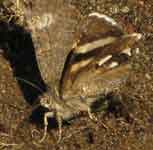
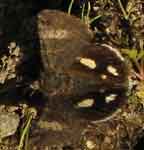
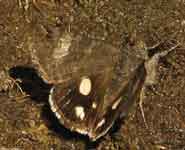
The very pretty, but in a muted sort of way, Brown Elfin butterfly was also at the beach at the same time and for the same reason.
Three photos of it are below...be sure to click on them to see the whole, larger image!
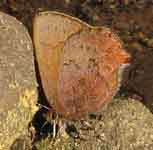


A surprise was that native Sulphur Buckwheat was growing in the pathway to the beach. We had 'collected' the beach material at a
nearby waterway, and apparently it came in as a seed, sprouted and flowered! Not a surprise, but ALWAYS a delight, was to find the
Hermit Warbler already using the pond's bog area as his own private bath! All the birds love it that we've provided perches for them in and around the pond. They land on these and then walk down them
until they are at the water's surface, take another step or two and then start fluttering and dipping - bird bathing. Other times
they use the shallow sandy beaches we've also purposely provided. Steep edges discourage wildlife use - if your pond already has steep edges,
try adding perches! The Yellow Warbler is a special delight each time he comes in to bathe.
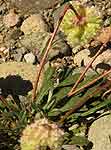
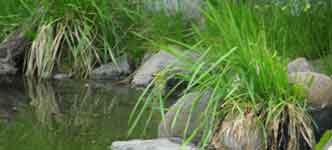
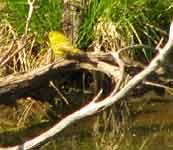
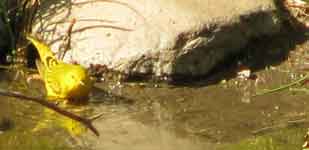
On the 23rd, as we looked out the kitchen window, we saw our first deer of the year. The native deer here is the Black-tailed. This mornings sighting was extra sweet....first
one doe came in and got a drink, then she turned and looked behind her and a 2nd doe came in. It turned and looked back and a young
yearling doe came in and then another young yearling doe came in! I wonder if they are two differnet generations from the same female
line?! Or maybe just friends?? They still had their heavier, grayer, winter coats on, although their redder, summer color, was beginning to show.
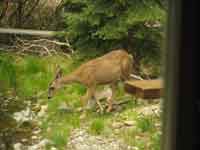
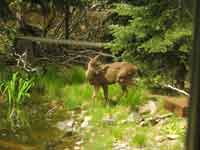
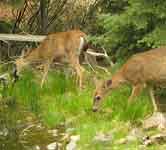
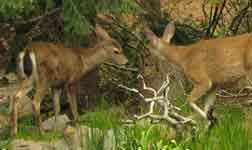
June
(Click on all images to enlarge them).
I managed to get back up to our McCloud home and pond by coming up for a few days with a friend who also loves nature! Thanks Nancy!! Right away
we started seeing activity on the pond. We had to get the book to be certain of the ID, but a subtly beautiful Hermit Thrush came in.
His reddish-colored tail made the ID. I wish he would have sung....they have a fantastic song, singing two or more notes at a time!
The male Western Tanager who also came in that day has nothing subtle about him! Nancy especially loves butterflies, so the visit by the Northern
Checkerspot delighted her. And, I noted something unusual: the pond didn't have but one pollywog in it - instead the floor of the
pond was covered with our Long-toed Salamander pups (larval form)!! There seemed to be one for every 6 square inches! It would seem that some factor
tipped the balance between the frogs and the salamanders this spring...research led us to believe the salamanders ate the pollywogs!
It's really difficult to photograph them underwater, especially with all the fir tree pollen floating on the surface....sorry!
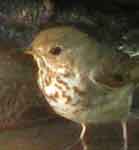


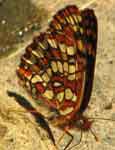
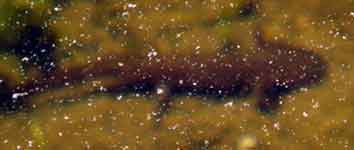
Bumble Bees are in trouble in some areas of the USA, but not at my McCloud home...we see many of them.
This Yellow-faced Bumble Bee seems to be searching for something other than pollen on this leaf - a drop of moisture?
And, although there weren't pollywogs in the pond, there were still a few Chorus Frogs in the pond. Most had moved
off to other areas nearby though, as is their custom. The purple leaf it is hanging onto is a new (native)
Western Water Lilly leaflet.
I was so happy to see it as it has taken years to get one established in the pond, no place in California seems to sell them.
It was nice sometimes just to look out at the pond - it would look so serene, so we'd feel that peace too.


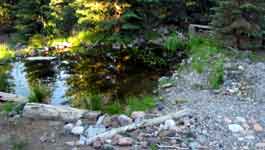
And, ta da, a day later, we recorded butterfly species #20 to visit the pond - the velvety Nelson's Cedar Hairstreak!
I keep a list of all the critters that visit the pond, with photos if I can get them. You can see it at Critters at our Shasta Pond.
Sometimes I'm surprised when I go back and look at the images I've taken....sometimes I get a "2fer". In this case I noticed
a Carpenter Ant near the Hairstreak! And sometimes what surprises me isn't the critter, it's the behavior.
The Twelve-spotted Skimmer is the usual dragonfly at our pond. But, it usually "Ts up" to perch, horizontal
on a branch. But it was HOT, in the upper 90s the day I took this image of one - and it was 'hang-perching' from a reed, a behavior
usually not exhibited by skimmers. If you look closely, you can see that the shadow of the reed is shading the skimmer's body,
and thus keeping him from overheating. If he flew away from the pond to land in the shade, he might not be there when the female
came in to oviposit...and he wants to make certain he'll be the one to fertilize her eggs!
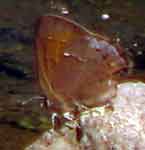

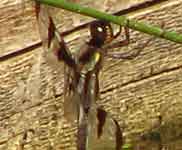
July
(Click on all images to enlarge them).
Hooray! Hooray!! Dave and I were able to come up to our McCloud home and pond for 7 weeks!! Well, we did leave to go to OR & WA during
those weeks, but it was wonderful to get to 'settle in' there! One of the first critters we noticed at the pond was the Familiar Bluet, a type of damselfly.
Damselflies hold their wings together, either alongside or sail-like, above their bodies. All Bluets in the West hold their wings alongside
their bodies. Other good news was that the native penstamen I'd planted next to the pond was in bloom and looking healthy.
We always try to record each bird species that visits. Our 2nd day there a pair of Nashville Warblers came into the pond
to bathe. They seemed in the photo to be having a conversation about the water temperature!
Just about the first creature to find our pond was the Backswimmer. I recall that the surface of the pond looked as if
it were raining as so many backswimmers dropped out of the sky and into the pond! Aptly named, they swim underwater on their backs!
They are predaceous, eating other insects and tiny crustaceans in the pond....and they can bite if handled roughly! Luckily, they
are only about a half inch long.

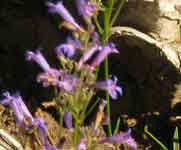
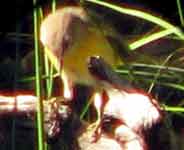
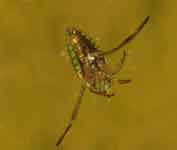
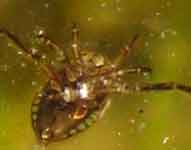
July is the month with the most species of dragonflies on the wing here in California, and our pond was busy making its own
contribution. The Twelve-spotted Skimmers that had oviposited in the pond last year now had offspring! It takes about a
year for a dragonfly to develop from egg to flying Ode. Almost everyday I found one or more emerging.
The first photograph below is of a emerging 12-spot (our nickname for them). It has just emerged from the pond and then from its exoskeleton
and has yet to spread its wings. The 2nd image is of a teneral 12-spot. Think of that as meaning tender! It has spread its new
wings out to dry. Soon it will take its maiden flight. Until its wings dry, touching them would ruin them. Thereafter, however,
holding a dragonfly by its wings won't harm them at all and is the accepted way to handle them. This one's wings weren't even showing color yet!
The next photo was taken the same day and is another male 12-spot. His wings are fully colored, but he is
still developing the pale blue pruinosity on his abdomen. It will get thick enough to obscure the yellow spots and even the brown on the abodmen.
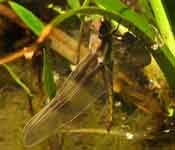

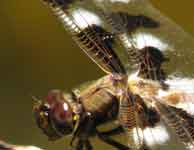

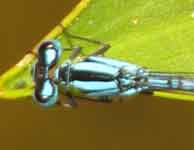
Damselflies can be damned difficult to ID. I don't like to catch the ones at our pond, so I put my watershoes on and waded in with
the camera securely tied around my neck to get pictures. And it looks like at least most of them are the Familiar Bluets.
Bluet's in the west are all blue and black patterned and hold their wings alongside their abdomens. Familiar Bluets are more blue than
black on their 3rd segment, and they have large upper appendages that end have a white 'button' on the tip. We might have also had a Northern
Bluet, but none of my pictures could prove it.
 On the 18th a doe brought her twin fawns into the pond for the first time. It was SO cute. They had, of course, never
experienced a non-solid surface before. They looked at it, they touched their hooves to it, then they gingerly stepped into it. But the
funniest moment was when one of them ducked its head underwater and came up sneezing! The fawn hadn't known you couldn't breathe water. Dave
was shooting a short video of them, and stopped just before that moment. Click on the larger image to the right to watch the short video. More
images from that day are below.
On the 18th a doe brought her twin fawns into the pond for the first time. It was SO cute. They had, of course, never
experienced a non-solid surface before. They looked at it, they touched their hooves to it, then they gingerly stepped into it. But the
funniest moment was when one of them ducked its head underwater and came up sneezing! The fawn hadn't known you couldn't breathe water. Dave
was shooting a short video of them, and stopped just before that moment. Click on the larger image to the right to watch the short video. More
images from that day are below.
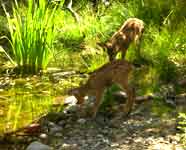

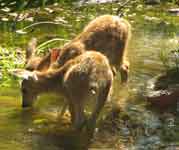
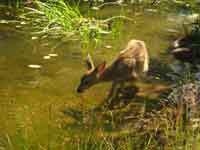
Then the next day our entertainment was supplied by a family of Western Bluebirds. As I've mentioned, most of our birds
prefer to bathe from the beach or a stick. But we've got one floating piece of log (it's actually anchored on a long tether), and that
was always the preferred batheing spot for the bluebirds. They would land nearby, then fly down to it, walk to the end where just a little
bit of it stuck out further, under the water, step onto it and flutter their wings and dip their torsos.
Also blue-colored (OK, those juvenile Bluebirds weren't blue yet!), and Dave's favorite bird, the Lazuli Bunting, also came
a-visiting. The male looks like a piece of the sky has dropped in, but his mate is very demurely colored.


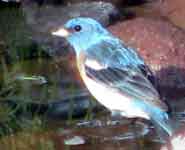
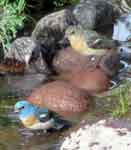
Some of the other birds we were able to record that week included Northern Flicker, Band-tailed Pigeon, Western Tanager, Orange-crowned Warbler,
and one we don't see very often, the Black-throated Gray Warbler. Can you guess who is who?
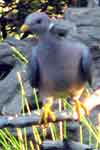
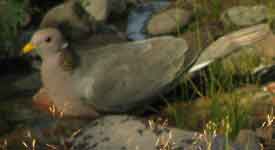
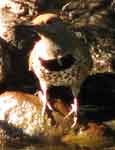
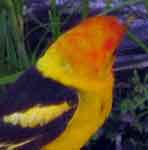

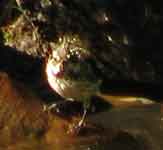
I guess you can tell we love our wildlife visitors. But this next sequence of pictures seems to tell a deer love story:
As we looked out the window, a doe appeared at the bog area, coming in for a drink. But just seconds later, we saw a stag coming up
behind her. She moved aside and he came in to imbide too. Then, she came back closer, and, nose to nose, they drank together! You have to
look closely to see him as he comes in on the first image...don't forget to click them to get the whole picture.
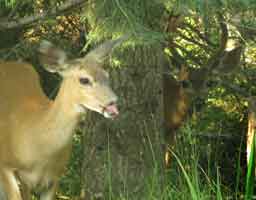
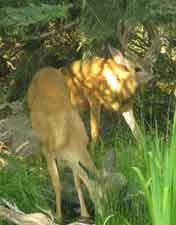


We were just loving being there and getting to see all the wild things visiting the pond. Here are some more of our visitors:
Dave's favorite, the Lazuli Bunting stayed around. And a new very young buck showed up - he was just starting to grow his antlers.
Another doe, with a single fawn, so perhaps a first year mother, also visited. These tiny fawns are adorable! In the mornings,
it seemed to 'rain' birds - I'd describe one saying, "It's a butterbut with a bright yellow throat, and Dave would say "no -
it's an Orange-crowned, dull all over," but we would both be correct!

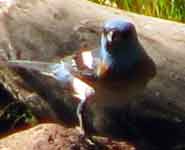
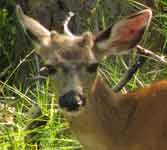
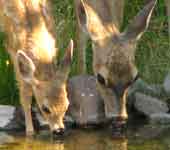
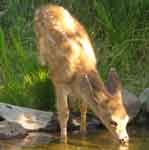
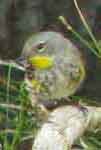

Please come back soon, I'm adding information, commentary and images whenever I can!
Kathy
Return to the Bigsnest Wildlife Pond's entry page.
Thanks for visiting!
I always enjoy comments Kathy Biggs